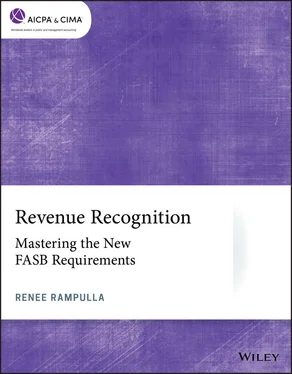Gains are increases in equity (net assets) from peripheral or incidental transactions of an entity and from all other transactions and other events and circumstances affecting the entity except those that result from revenues or investments by owners.
FASB Concept Statement No. 6, further states in paragraph 84, that
Gains and losses result from entities’ peripheral or incidental transactions and from other events and circumstances stemming from the environment that may be largely beyond the control of individual entities and their managements. Thus, gains and losses are not all alike. There are several kinds, even in a single entity, and they may be described or classified in a variety of ways that are not necessarily mutually exclusive.
The difference between revenue and gains
While revenue and gains may appear to be similar, some significant differences exist. As described in the definition, revenue is the result from an entity’s ongoing major or central operations and activities, meaning revenue is derived from producing goods, rendering services, or other activities. Gains result from an entity’s peripheral or incidental transactions and from other events and circumstances stemming from an environment that may be largely beyond the control of the entity and their management. Understanding the difference between gains and revenue is important because gains from peripheral or incidental transactions are outside the scope of FASB ASC 606, Revenue from Contracts with Customers , and therefore outside any of the course’s content.
 Exercise 2-1
Exercise 2-1
Based upon the previously mentioned definitions, which of the following are revenue and which are gains?
1 An entity sells equipment for $600. They manufacturer the equipment at a cost of $500.
2 An entity sells equipment they no longer need for $600. They bought the equipment for $1,000 five years ago, and have been depreciating it on a straight-line basis assuming a 10-year useful life.
1 Which best describes the definition of revenue as defined in FASB ASC 606?Inflows of assets of an entity or settlements of its liabilities (or a combination of both) from deriving or producing goods, rendering services, or other activities that constitute the entity’s ongoing major or central operation.The results of an incidental transaction from an event and circumstance stemming from an environment beyond the control of individual entity.Outflows or other enhancements of an entity or settlements of its liabilities (or a combination of both) from deriving or producing goods, rendering services, or other activities that constitute the entity’s ongoing major or central operation.The results of a peripheral transaction from an event and circumstance stemming from an environment beyond the control of individual entity.
How to identify a contract(s) with a customer
FASB ASC 606 defines a contract as “an agreement between two or more parties that creates enforceable rights and obligations.” Paragraph 1 of FASB ASC 606-10-25 further specifies that a contract(s) with a customer exists only when all of the following criteria have been met:
The parties to the contract have approved the contract (in writing, orally, or in accordance with other customary business practices) and are committed to perform their respective obligations.
The entity can identify each party’s rights regarding the goods or services to be transferred.
The entity can identify the payment terms for the goods or services to be transferred.
The contract has commercial substance (that is, the risk, timing, or amount of the entity’s future cash flows is expected to change as a result of the contract).
It is probable that the entity will collect substantially all of the consideration to which it will be entitled in exchange for the goods or services that will be transferred to the customer
Here are some important considerations when assessing whether a contract exists with a customer:
A contract does not exist if each party to the contract has the unilateral enforceable right to terminate a wholly unperformed contract without compensating the other party or parties.
When evaluating whether collectability of an amount of consideration is probable, an entity needs to consider only the customer’s ability and intention to pay that amount of consideration when it is due. The amount of consideration to which the entity will be entitled may be less than the price stated in the contract if the consideration is variable because the entity may offer the customer a price concession. Some entities find the collectability criteria difficult to assess because of certain variables, such as contract modifications or non-cash considerations, that could that potentially impact the criteria.
 Key point
Key point
In order to meet the definition of a contract with a customer that is within the scope of FASB ASC 606, the contract does not have to be in writing. A contract can be written, oral, or implied (as a customary business practice).
 Enforceable rights
Enforceable rights
The definition of a contract creates enforceable rights and obligations. It is important to realize that an entity’s ability to enforce these rights and obligations may vary. Certain practices and processes for establishing contracts with customers can vary across legal jurisdictions (foreign and domestic), industries, and entities. In some places, consumer-friendly laws may invalidate a company’s contracts with its customers if challenged in a court of law. Therefore, careful consideration will be needed for contracts that have been approved and committed to by the entity and its customers that may not be enforceable in a court of law in a specific jurisdiction. This evaluation may be more complex in situations in which contracts are entered into across multiple jurisdictions.
An entity is required to assess whether it is probable that they will collect substantially all of the considerationthey will be entitled to in exchange for the goods or services that will be transferred to the customer. Keep in mind that part of identifying whether a contract with a customer exists is based on the entity’s assessment of whether the customer has the ability and the intention to pay the consideration in exchange for the goods or services being transferred. The objective of this assessment is to evaluate whether there is a substantive transaction between the entity and the customer, which is a necessary condition of step 1.
The collectability assessment is partly a forward-looking assessment. This means that an entity should consider all of the facts and circumstances, including customary business practices and the entity’s knowledge of their customer, when determining whether it is probable that they will collect substantially all of the consideration to which they are entitled. Keep in mind that the assessment is not necessarily based on the customer’s ability and intention to pay the entire amount of promised consideration for the entire duration of the contract. When making this assessment, an entity should determine whether the contractual terms and its customary business practices indicate that the entity’s exposure to credit risk is less than the entire consideration promised in the contract because the entity has the ability to mitigate its credit risk. Examples of contractual terms or customary business practices that might mitigate the entity’s credit risk include the following:
Читать дальше

 Exercise 2-1
Exercise 2-1 Key point
Key point Enforceable rights
Enforceable rights










